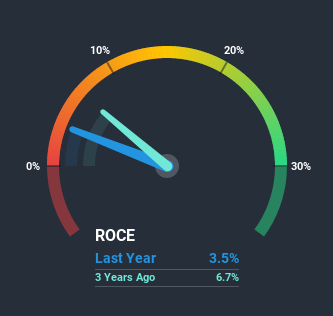Austevoll Seafood (OB:AUSS) Is Reinvesting At Lower Rates Of Return

Did you know there are some financial metrics that can provide clues of a potential multi-bagger? In a perfect world, we'd like to see a company investing more capital into its business and ideally the returns earned from that capital are also increasing. Basically this means that a company has profitable initiatives that it can continue to reinvest in, which is a trait of a compounding machine. Although, when we looked at Austevoll Seafood (OB:AUSS), it didn't seem to tick all of these boxes.
What is Return On Capital Employed (ROCE)?
For those that aren't sure what ROCE is, it measures the amount of pre-tax profits a company can generate from the capital employed in its business. To calculate this metric for Austevoll Seafood, this is the formula:
Return on Capital Employed = Earnings Before Interest and Tax (EBIT) ÷ (Total Assets - Current Liabilities)
0.035 = kr1.2b ÷ (kr40b - kr5.6b) (Based on the trailing twelve months to December 2020).
Therefore, Austevoll Seafood has an ROCE of 3.5%. Even though it's in line with the industry average of 4.3%, it's still a low return by itself.
View our latest analysis for Austevoll Seafood

In the above chart we have measured Austevoll Seafood's prior ROCE against its prior performance, but the future is arguably more important. If you'd like, you can check out the forecasts from the analysts covering Austevoll Seafood here for free.
How Are Returns Trending?
In terms of Austevoll Seafood's historical ROCE movements, the trend isn't fantastic. Around five years ago the returns on capital were 7.9%, but since then they've fallen to 3.5%. Meanwhile, the business is utilizing more capital but this hasn't moved the needle much in terms of sales in the past 12 months, so this could reflect longer term investments. It may take some time before the company starts to see any change in earnings from these investments.
In Conclusion...
To conclude, we've found that Austevoll Seafood is reinvesting in the business, but returns have been falling. Although the market must be expecting these trends to improve because the stock has gained 97% over the last five years. However, unless these underlying trends turn more positive, we wouldn't get our hopes up too high.
Austevoll Seafood does have some risks though, and we've spotted 2 warning signs for Austevoll Seafood that you might be interested in.
While Austevoll Seafood may not currently earn the highest returns, we've compiled a list of companies that currently earn more than 25% return on equity. Check out this free list here.
When trading Austevoll Seafood or any other investment, use the platform considered by many to be the Professional's Gateway to the Worlds Market, Interactive Brokers. You get the lowest-cost* trading on stocks, options, futures, forex, bonds and funds worldwide from a single integrated account. Promoted
New: Manage All Your Stock Portfolios in One Place
We've created the ultimate portfolio companion for stock investors, and it's free.
• Connect an unlimited number of Portfolios and see your total in one currency
• Be alerted to new Warning Signs or Risks via email or mobile
• Track the Fair Value of your stocks
This article by Simply Wall St is general in nature. It does not constitute a recommendation to buy or sell any stock, and does not take account of your objectives, or your financial situation. We aim to bring you long-term focused analysis driven by fundamental data. Note that our analysis may not factor in the latest price-sensitive company announcements or qualitative material. Simply Wall St has no position in any stocks mentioned.
*Interactive Brokers Rated Lowest Cost Broker by StockBrokers.com Annual Online Review 2020
Have feedback on this article? Concerned about the content? Get in touch with us directly. Alternatively, email editorial-team (at) simplywallst.com.
About OB:AUSS
Austevoll Seafood
A seafood company, engages in the production of salmon and trout, white fish, and pelagic in Norway, the European Union, the United Kingdom, Eastern Europe, Africa, North America, Asia, and South America.
Very undervalued with excellent balance sheet.


